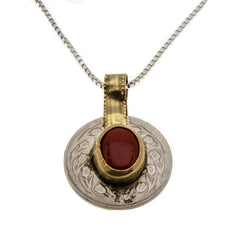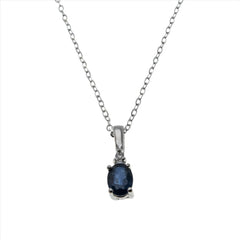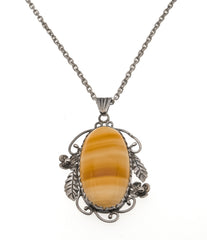Egyptian Revival - Vintage Gold Plated Signed 'Wedgwood' Jasperware Black Basalt Egyptian Hieroglyphic Pendant & Chain (VP173)
Rarities Antique Jewelry
Egyptian Revival - Vintage Gold Plated Signed 'Wedgwood' Jasperware Black Basalt Egyptian Hieroglyphic Pendant & Chain. Featuring a signed WEDGWOOD MADE IN ENGLAND. black basalt pendant, Egyptian Revival styling, and quality craftsmanship. This intriguing piece is made up from Wedgewood jasperware, which showcases beautiful hieroglyphics, including the Egyptian mother goddess, Harthor. The obelisk pendant is black with raised hieroglyphics on the front, and a smooth finish on the back, with the WEDGWOOD signature. The surmount is triangular shaped, with a fluted decoration, and a lovely rich gold color. The chain is a sturdy curb link design, and original to the piece. The wonderful necklace is accompanied by the original box, and paperwork. This vintage pendant would make a great gift for any ancient Egyptian enthusiast or a wonderful addition to any vintage jewelry collection.
History: The word hieroglyph literally means "sacred carvings". The Egyptians first used hieroglyphs exclusively for inscriptions carved or painted on temple walls. This form of pictorial writing was also used on tombs, sheets of papyrus, wooden boards covered with a stucco wash, potsherds and fragments of limestone.
Hieroglyphics are important today because they are one of the oldest forms of writing known. They help us to understand ancient Egyptian culture, life, and history.
Hieroglyphs are always read from top to bottom but sometimes you start on the left side (like in English) and sometimes on the right. The animals, birds or people used in hieroglyphs always face the beginning of the sentence so that tells you where to start.
Hathor was often depicted as a cow, symbolizing her maternal and celestial aspect, although her most common form was a woman wearing a headdress of cow horns and a sun disk.
An obelisk (/ˈɒbəlɪsk/; from Ancient Greek: ὀβελίσκος obeliskos; diminutive of ὀβελός obelos, "spit, nail, pointed pillar") is a tall, four-sided, narrow tapering monument which ends in a pyramid-like shape or pyramidion at the top.
Scholars believe that obelisks represented eternity and immortality, and their long, tapering form functioned to connect the heavens and the earth. Their pinnacles were typically covered in gold to reflect the sunlight.
Wedgwood jasperware, type of fine-grained, unglazed stoneware introduced by the English potter Josiah Wedgwood in 1775as the result of a long series of experiments aimed at discovering the techniques of porcelain manufacture. Its name derives from the fact that it resembles the natural stone jasper in its hardness.
The first known gold plating occurred in northern Peru, where Pre-Columbian smiths gilded and silvered copper pieces by electrochemical replacement techniques. During excavations in the late 1980s, archaeologists discovered gold and silver ornamental and ceremonial artifacts dating all the way back to AD 50-300.
Measurements: Pendant 70.00 mm x 22.00 mm Chain 18"
Stone Size: Wedgwood Basalt 55.00 mm x 22.00 mm
Weight: 15.60 grams
Condition: Excellent
Origin: England
Date: Circa 1970



















